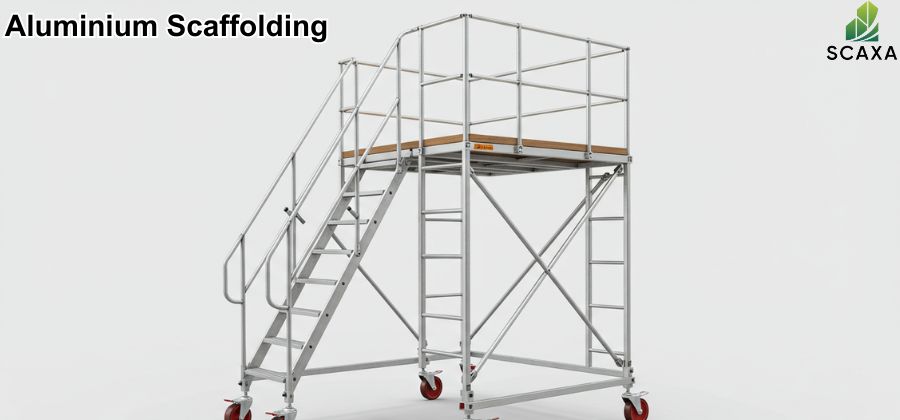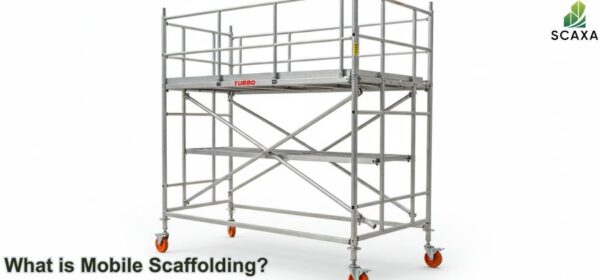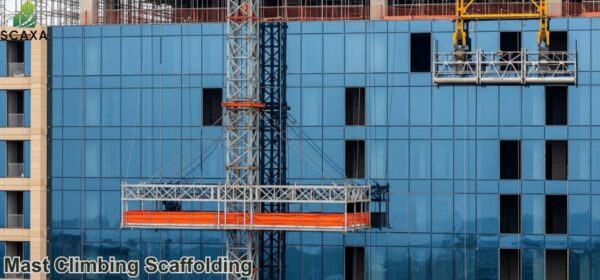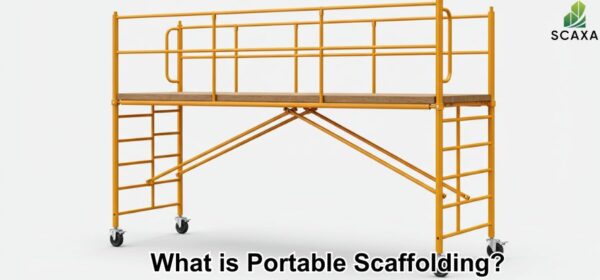Aluminium scaffolding works by interlocking lightweight frames with braces and platforms to form a stable structure that offers elevated access for workers. Its mobile modular design has wheels for ease of movement. Its height adjustment feature lets workers change the platform height as per project requirements.
The main benefits of aluminum scaffolding include its quick assembly/disassembly and lightweight, easy-to-handle framework. Besides, aluminum scaffolds are portable, durable, and low-maintenance. Aluminum scaffolding is mainly used in infrastructure projects, residential and industrial construction, repair and maintenance, events, and renovation.
What is Aluminium Scaffolding?
Aluminium scaffolding is a lightweight, corrosion-resistant, and durable temporary structure that offers safe access at various heights to construction, maintenance,e and industrial project workers. Unlike steel scaffolding, which is prone to wear and tear, especially rust, aluminium scaffolding is resistant to rust, making it ideal for use in coastal and industrial areas where moisture is present and harsh environmental exposure is unavoidable. Although aluminium scaffolding is not intended for heavy load transfer like steel scaffolding, it provides ample support for regulated construction, maintenance, and repair work.
How much is the rental of Aluminium Scaffolding in UAE?
The rental cost of aluminum scaffolding in the UAE depends on three factors: type and dimensions, rental duration, and additional services.
- Type and Dimensions: The rental cost of single-width towers (approximately 1.8m length × 0.85m width) is lower than that of double-width towers (around 2.5m length × 1.45m width. The price of aluminum mobile towers increases with the requirement of more height in this temporary structure.
- Rental Duration: The rental cost of an aluminum scaffold decreases with rental duration. Expect discounted rates for a more extended rental period. Companies offer daily, weekly, and monthly rental service quotes.
- Additional Services: Rental costs increase with additional services such as dismantling, on-site assembly and transportation. Some aluminium scaffold rental companies offer package deals that include all services in a single package, while others charge separately for each service.
What are the Advantages of Aluminium Scaffolding?
The eight advantages of aluminium scaffolding are as follows:
- Lightweight and Easy to Handle
- Corrosion Resistant
- Quick Assembly and Disassembly
- Portability and Mobility
- Low Maintenance
- Durable and Long-Lasting
- Environmentally Friendly
- Cost-Effective Over Time

1. Lightweight and Easy to Handle
When you compare aluminium scaffold with steel scaffolding, the former scaffold is lightweight and easy to handle. It reduces most workers’ construction fatigue with the erection and assembly of steel and other traditional scaffolding. Workers can easily assemble, disassemble, reposition, and transport aluminium scaffolds with minimal effort and time. When a task requires frequent relocation of a temporary structure, project managers rely on the aluminium scaffold as it doesn’t require heavy lifting during setup and speeds up work progress.
2. Corrosion Resistance
Aluminium naturally produces a protective oxide layer that makes it highly resistant to environmental degradation, especially rust. This property of aluminium scaffold makes it a good temporary structure for indoor and outdoor applications, especially in coastal areas with high humidity. Steel scaffolds usually deteriorate over time in coastal areas and regions with heavy rain climates, while aluminum scaffolds remain intact. The aluminum scaffold’s visual appeal and structural integrity do not deteriorate even when exposed to extreme elements like heavy rain or humidity.
3. Quick Assembly and Disassembly
The rapid assembly and disassembly make aluminum scaffolds an appealing temporary structure among construction workers. It is super quick to erect and offers a tool-free assembly solution. Project efficiency improves with the use of aluminum scaffold, as it cuts the time of assembly and disassembly in half. Mobile aluminum towers reduce labor costs, as they are simple to set up by one or two people.
4. Portability and Mobility
Aluminum scaffolding has become a go-to solution for many industries because of its portability. This type of scaffold can be folded into compact sections whenever you need to transport it from one site to another. Due to their compact storage, it’s easy for you to move them inside elevators or narrow hallways. They are lightweight, so you can move them on delicate floors or high-traffic indoor areas such as offices, warehouses and malls without causing any damage.
5.L ow Maintenance
Aluminium scaffolding is low-maintenance compared with steel scaffolding, which requires regular painting and rust treatment. When it comes to the maintenance of aluminum scaffolding, all you need to do is perform regular inspections and cleaning. Aluminum scaffolds require minimal upkeep for their moving parts that may get stuck or break down, so they reduce long-term operational costs.
6. Durable and Long-Lasting
Aluminium scaffold is highly durable and lasts for many years without significant wear or loss of performance with proper use and care. It is a material that doesn’t crack, splinter, or warp and shows excellent corrosion resistance. Therefore, it remains structurally sound even when exposed to harsh environments for years.
7. Environmentally Friendly
The aluminum scaffold is 100% recyclable and can be reused without any loss in quality. These days, you can get aluminum scaffolds made of recyclable material. Eco-conscious project managers reduce the environmental footprint of their projects by relying on aluminum scaffolding.
8. Cost-effective Over Time
The initial investment in aluminium scaffolding is higher than that in steel scaffolding. However, this option becomes cost-effective over time as it requires low maintenance, little labor, and a lower transportation cost. Frequent users can make a smart choice by investing in aluminum scaffolding, as it requires fewer replacements and boosts project efficiency with low downtime.
What are the Disadvantages of Aluminium Scaffolding?
The six disadvantages of aluminium scaffolding are as follows:
- Limited Load Capacity
- Higher Initial Cost
- Height Limitations
- Electrical Conductivity
- Thermal Conductivity
- Limited Availability
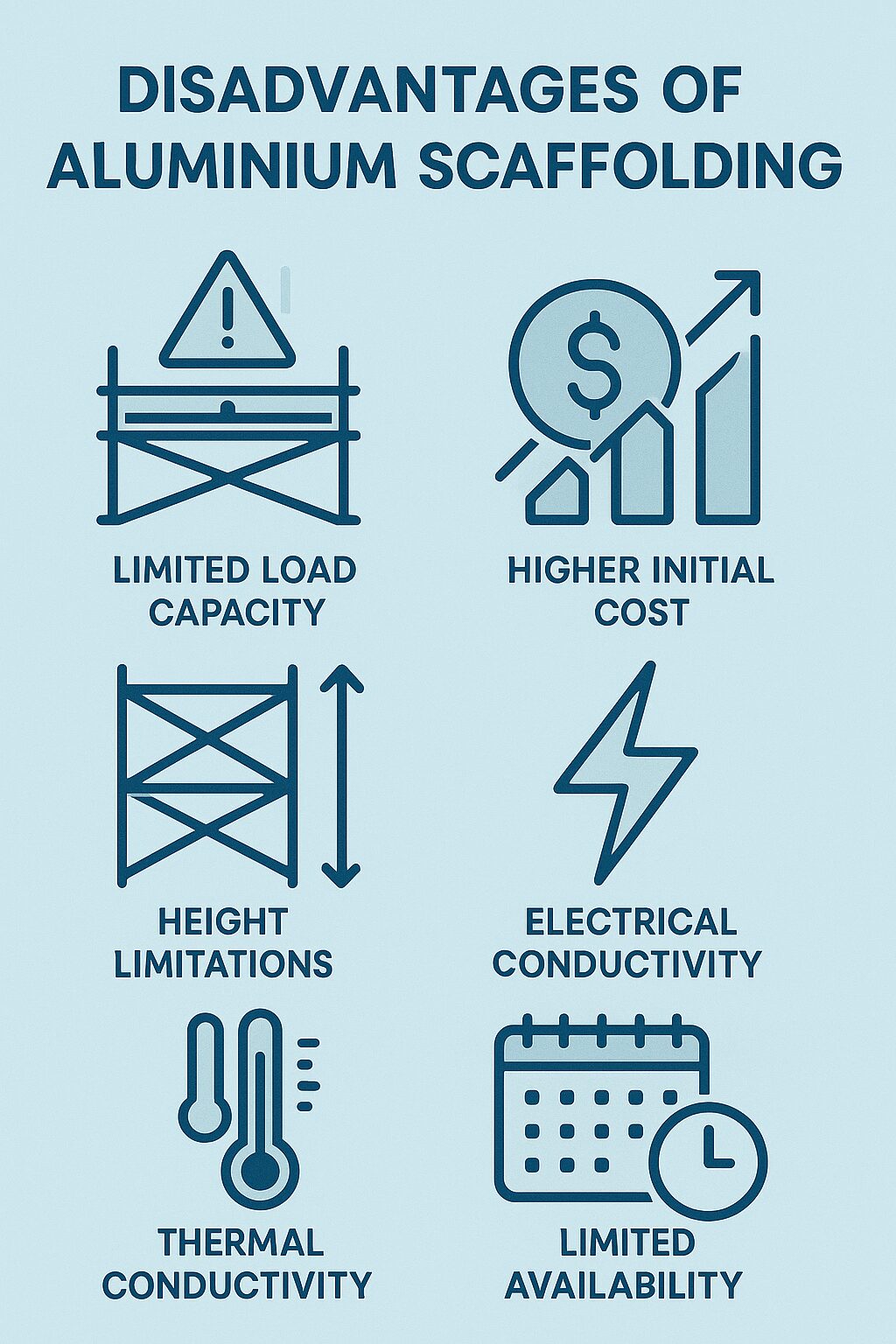
1. Limited Load Capacity
You can’t use an aluminium scaffold for heavy-duty tasks because it doesn’t offer the same load-bearing strength as steel. This scaffold is not suitable for heavy equipment, bulky construction material transport or large crews. Overloading an aluminium scaffold can lead to structural collapse or deformation, a serious safety risk.
2. Higher Initial Cost
The cost of aluminum scaffolding is high, with a steeper price tag, especially when you shop for mobile towers or modular systems. The upfront high investment in this type of scaffold is a barrier for small contractors or those who plan to use it only once. However, renting an aluminium scaffold is a cost-effective option for occasional use.
3. Height limitations
Aluminium is a lightweight material that can’t be extended to significant height without proper anchor systems or outriggers. It becomes unstable at a significant height. Wind load or uneven surfaces make the whole structure unstable. When working on tall buildings or multi-story construction, aluminium scaffold has height limitation and therefore contractors prefer steel scaffolding for such tasks.
4. Electrical Conductivity
Aluminium is a highly conductive metal, which makes it dangerous for use near electrical wires, high-voltage equipment, and power lines. When a project involves an electrical system, project managers prefer a non-conductive scaffold, such as fiberglass,s over an aluminum scaffold.
5. Thermal conductivity
Aluminium has thermal conductivity properties as this metal readily absorbs and conducts heat. As a result, it is an unsafe temporary structure to use in hot climates. This temporary structure becomes hot to the touch when exposed to direct sunlight. Conversely, freezing temperatures make the platform icy and slippery, increasing the risk of burns and slips. Workers must wear protective gloves and take extra precautions when erecting or dismantling scaffolding in such an environment.
6. Limited availability
Aluminum scaffolds are not readily available in remote areas. Project managers working on rural projects usually rent scaffolds or transport them from city areas. Some projects require a custom or specialty configuration of aluminum scaffolds. Limited availability is a primary concern because you must order this scaffold from the city area. Customization and transportation factors will increase overall costs, leading to project delays.
What are the uses of Aluminium Scaffolding?
The six uses of aluminium scaffolding are as follows:
- Construction & Renovation
- Maintenance & Repairs
- Events & Entertainment
- Industrial Applications
- Residential Use
- Infrastructure Projects

1. Construction and Renovation
Aluminum scaffolding is commonly used in renovation and construction projects. Whether you are building a new structure or simply performing drywall installation tasks, aluminum scaffolding, especially mobile scaffolding, makes it easy to work at varied heights. The modular design of this temporary structure makes the assembly and disassembly process super quick while reducing labor time and increasing project efficiency. Mobile aluminum scaffolds are commonly used in window fitting, plastering tasks, and painting for both indoor and outdoor projects.
2. Maintenance and Repairs
Aluminum scaffolding is used for maintenance and repair, especially for projects requiring frequent setup. Electricians, plumbers, and HVAC technicians use aluminum scaffolds to access rooftops, high walls, and ceiling areas. The rust-resistance properties of this temporary structure make it an ideal access system for outdoor maintenance tasks. The quick setup and breakdown of the aluminum scaffold make it an ideal temporary structure to be used for facility upkeep in airports, hospitals, schools, and malls. Workers can keep up with maintenance and repair projects without disrupting normal life operations.
3. Events and Entertainment Industry
Aluminum scaffolds are commonly used in the event and entertainment industry. They are essential in building temporary structures such as crowd control barriers, stage platforms, lighting rigs, speaker stands, and camera towers. Technicians can form a stable, portable framework for heavy lighting and sound equipment. Ease of assembly and disassembly, and frequent setup of aluminium scaffolding are the main reasons they are commonly used in concerts, festivals, film sets, exhibitions, and sports venues.
4. Industrial Applications
Aluminum scaffolding is used in factories, production plants, and warehouses where workers need access to difficult-to-reach areas for ductwork, maintenance, inspection, and machinery installation. Aluminum scaffolds prove useful in such industrial applications because they are easy to maneuver and can be built around narrow spaces and complex equipment. Mobile scaffolds with non-marking caster wheels are used for sensitive industrial flooring and cleanrooms.
5. Residential use
Aluminum scaffolding is becoming a favorite among DIYers who are ready to spend extra money on a simple temporary structure to set up and break down while making frequent setups quite effortless. Homeowners use aluminum scaffolds for exterior painting, tree trimming, gutter cleaning, and roof repair. The lightweight aluminium scaffold allows homeowners to do high wall decoration and indoor ceiling work easily. The modular nature of aluminum scaffolding lets owners fold its frames and store them safely. The aluminum scaffold is a safer and more stable option as compared with ladders when it comes to working at height.
6. Infrastructure Projects
Aluminum scaffolding is used for infrastructure projects such as bridge construction, road overpasses, railway maintenance, and airport terminals. Due to their high durability and mobility, aluminum scaffolds have proven effective when handling remote projects. Inspection teams, engineers, and workers rely on this temporary structure because it enables safe access while providing a perfect balance of corrosion resistance and portability in large-scale environments.
What are the Components of Aluminium Scaffolding?
Four components of aluminum scaffolding are as follows:
- Structural Components
- Base and Mobility Components
- Safety and Access Components
- Connectors and Accessories
1. Structural Components
Structural components of an aluminum scaffold include vertical frames, horizontal braces, and diagonal braces. Vertical frames are made of high-grade aluminum tubes selected based on their strength-to-weight ratio and corrosion resistance. Horizontal braces provide lateral stability in the structure and define the platform levels. Diagonal braces support horizontal and vertical frames and prevent swaying. Working platforms or decks are integral structural components of aluminum scaffolds. Platforms are made from either aluminum planks or plywood boards reinforced with aluminum frames. The working platform has anti-slip finishes for added safety for workers. Platforms are usually lightweight, resistant to wear and tear, and always locked in place to offer a stable surface for workers.
2. Base and Mobility Components
Every aluminum scaffold has a base component, such as base plates, that provides support to the entire structure. Base plates distribute the load evenly and keep the scaffold level, especially on uneven ground or rough surfaces. Adjustable screw jacks are used alongside base plates so that the height of the structure can be adjusted easily. Mobility components of the aluminum mobile scaffold are caster wheels that have a locking mechanism to secure the scaffold in place during use. Caster wheels enable ease of movement on a job site where construction workers need to reposition temporary structures repeatedly.
3. Safety and Access Components
Safety components of aluminum scaffolds include guardrails, midrails, and toeboards. These components prevent falls and ensure that workers have a safe and stable surface to stand on. Guardrails and midrails are safety rails inside on the edges of the platform to keep users from falling off the edges. Toeboards are installed on the platform to prevent tools and materials from slipping off the structure or causing any accidents or damage on the ground. Access components of aluminum scaffolding include ladders, stairways, and built-in climbing frames. Internal ladders let workers ascend without exiting the structure. The large aluminum scaffold has a complete staircase module for safe access between different levels. Hatch platforms with trap doors make internal access to the overall temporary structure simple and easy.
4. Connectors and Accessories
Connectors are used to keep the components of aluminum scaffold together, while accessories allow you to customize scaffolding setups per your project specifications. Connectors include locking pins, couplers, and clamps. These components are used to put different parts of the scaffolding together. Modern aluminum scaffolds usually have a quick lock mechanism to speed up assembly and ensure safe and firm connections. Outriggers are the most common accessories for aluminum scaffolds. They are used to extend the base footprint and to prevent tipping. Project managers rely on accessories such as platform extensions, tool trays, weatherproof covers, and safety harness attachment points to enhance scaffold safety and functionality.
What are the Safety Guidelines for Aluminium Scaffolding?
The six safety guidelines for aluminium scaffolding are as follows:
- Pre-Use Inspection
- Assembly and Structural Integrity
- Fall Protection
- Electrical Safety
- Weather Considerations
- Maintenance and Storage
1. Pre-use Inspection
Before you use an aluminum scaffold for any routine task, you need to perform an inspection. This inspection aims to check for visible damage, such as loose connections, unstable joints, cracks, or missing lock pins. Another reason to perform pre-inspection is to ensure that parts are fully compatible. Using incompatible components often impacts structural integrity and causes the structure to collapse. During inspection, the inspector must check that the platform is free of oil, debris, or paint to prevent falls or accidental slip and trip incidents. Readily fix issues in the aluminum scaffold structure if the inspector notices any damage. The inspector must keep safety markings and all labels intact and legible.
2. Assembly and structural integrity
Proper assembly is certainly the most critical factor when it comes to maintaining the structural integrity of aluminum scaffolds. Every scaffold comes with a manufacturer’s guideline for compatible components and setups. Always follow these guidelines to avoid fall incidents. Try to set up an aluminum scaffold on firm and level ground. Use stabilizers, adjustable base plates or screw jacks to stabilize the aluminum scaffold framework on uneven ground. Make sure that every brace, lock and support is fully secure in its place. Install toeboards and guardrails on the open sides when the platform height exceeds 6 feet or 1.8 meters. Workers using mobile aluminium scaffolds must lock wheels attached to the scaffold so that this temporary structure doesn’t shift or move away during work. Sticking with height and load limits while working on the platform is essential to prevent structural collapse or tipping.
3. Fall protection
Fall protection is the most critical safety guideline for aluminum scaffolds. It requires the installation of guardrails into a framework, especially in high-risk environments. Workers must use personal fall arrest systems that consist of harnesses and lifelines while working at height. Climbing the scaffold frame is prohibited for workers. Workers must be trained to use access points such as internal stairways and ladders that must be secured in place.
4. Electrical Safety
Aluminium is a highly conductive metal and requires special electrical safety measures. It is strongly advised not to use aluminum scaffolds near exposed electrical wiring, live electrical equipment, or overhead power lines. It’s better to go with fiberglass scaffolding when working in an electrical-sensitive environment. Fiberglass is a non-conductive material and ensures worker safety near electrical points. Workers working on aluminum scaffolding must maintain safe clearances and use insulated tools to protect themselves from accidental electrocution.
5. Weather Considerations
Safety on an aluminum scaffold is drastically compromised in extreme weather conditions. Aluminum is highly resistant to rust, but becomes slippery in wet and icy weather scenarios. Strong winds can cause tall scaffold towers to shift, especially when they are not properly anchored. Workers must stop working on aluminum scaffolding during heavy rain, fog, or snow. All the equipment on the scaffold should be covered or secured in harsh weather conditions. Project managers constantly monitor local weather reports to keep up with daily weather conditions and must postpone work when extreme weather is present.
6. Maintenance and Storage
Project managers must store scaffolds properly to improve the long-term safety and usability of the aluminum scaffolds. Ensure the scaffold is thoroughly cleaned after work; workers must remove debris, dust, paint, and concrete residues. Dust and debris, when piled up, usually interfere with locks and joints. Regular inspection of moving parts of the scaffold, such as hinges, lock mechanisms, and wheels, should be done. When selecting a storage space for an aluminum scaffold, storing it in a dry and fully covered area is a good idea to protect it from extreme weather and other elements. Store each scaffold component in an organized manner to prevent accidental damage or bending.
What is the Maximum Height for a Ladder Jack Scaffold?
The maximum height for a ladder jack scaffold is 20 feet. Platform height should not be more than 6.1 meters or 20 feet. When the ladder jack scaffold height is more than 20 feet, workers are prohibited from working on such a high platform.



